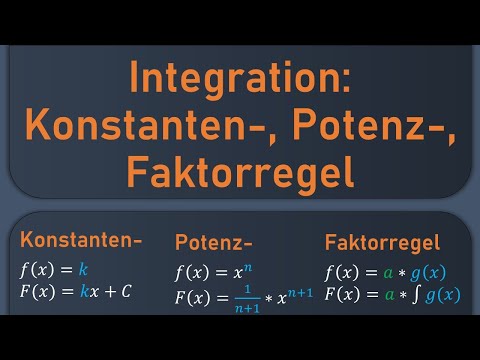Konstanten, Potenz- und Faktorregel
i
Tipp
Vergiss nicht bei unbestimmten Integralen spätestens am Ende noch die Integrationskonstante $\color{purple}{C}$ zu setzen.
Konstantenregel
Wenn im Integral nur eine Konstante $k$ steht, dann ist das Integral:
$\int k\,\mathrm{d}x=kx+C$
Beispiele
- $\int \color{red}{2}\,\mathrm{d}x=\color{red}{2}x\color{purple}{+C}$
- $\int \color{red}{5}\,\mathrm{d}x=\color{red}{5}x\color{purple}{+C}$
Potenzregel
Das Integral von Potenzen in der Form $x^n$ ist:
$\int x^n \,\mathrm{d}x=$ $\frac{1}{n+1}x^{n+1}+C$
!
Beachte
$n$ darf jede beliebige reelle Zahl außer -1 sein, denn sonst würde man durch 0 dividieren.
$n\in\mathbb{R}\backslash\{-1\}$
$n\in\mathbb{R}\backslash\{-1\}$
Beispiele
- $\int x^\color{red}{3} \, \mathrm{d}x $ $= \frac{1}{\color{red}{3}+1}x^{\color{red}{3}+1} $ $= \frac{1}{4}x^{4}\color{purple}{+C}$
- $\int x^\color{red}{-2} \, \mathrm{d}x $ $= \frac{1}{\color{red}{-2}+1}x^{\color{red}{-2}+1} $ $= -x^{-1} \color{purple}{+C}$
Faktorregel
Ein konstanter Faktor kann vor das Integralzeichen gezogen werden.
$\int a \cdot g(x) \, \mathrm{d}x =$ $ a \cdot \int g(x) \, \mathrm{d}x$
Beispiele
Hier wird die Potenzregel und die Faktorregel angewendet:
- $\int\color{red}{4}x^3 \, \mathrm{d}x$ $=\color{red}{4}\cdot \int x^\color{blue}{3} \,\mathrm{d}x$ $=4\cdot\frac{1}{\color{blue}{3}+1}x^{\color{blue}{3}+1}$ $=x^4\color{purple}{+C}$
- $\int\color{red}{-3}x \, \mathrm{d}x$ $=\color{red}{-3}\cdot \int x^\color{blue}{1} \,\mathrm{d}x$ $=-3\cdot\frac{1}{\color{blue}{1}+1}x^{\color{blue}{1}+1}$ $=-\frac32x^2\color{purple}{+C}$
!
Beachte
Es ist immer wichtig zu beachten, nach welcher Variable integriert wird.
Beispiel:
$\int 3\,\color{red}{\mathrm{d}y}=3\color{red}{y}+C$
Beispiel:
$\int 3\,\color{red}{\mathrm{d}y}=3\color{red}{y}+C$
Konstanten- Potenz- Faktorregel beim Integrieren, Integrationsregeln, Stammfunktion
Kooperation mit dem Kanal von Mister Mathe
Die Konstantenregel, die Potenzregel und die Faktorregel sind die drei grundlegendsten Regeln zum Integrieren von Funktionen.
i
Tipp
Wenn man die Ableitungsregeln gut beherrscht, kann man diese auf sein Ergebnis anwenden. Wenn die Ableitung des Ergebnisses die Ausgangsfunktion ergibt, dann wurde richtig integriert.

